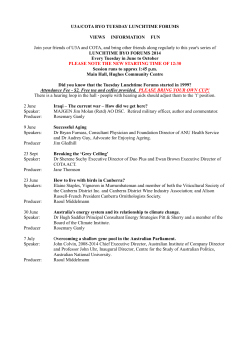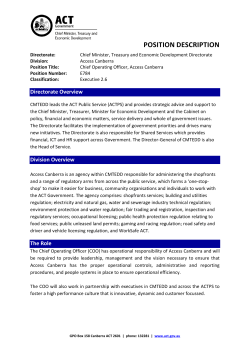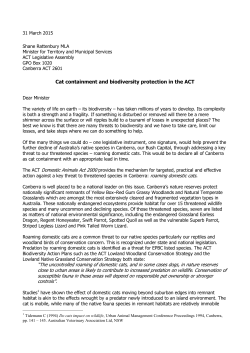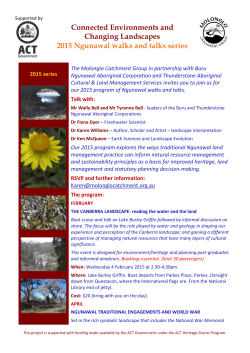
Towards an ACT Region Food Policy and Food Plan March 2015
Discussion Paper: Towards an ACT Region Food Policy and Food Plan March 2015 An initiative of the Conservation Council ACT Region in collaboration with Canberra City Farm, Canberra Organic Growers Society, Fusion, Slow Food Canberra and SEE-Change. This paper was prepared by Eleanor Robson who undertook an Internship with the Conservation Council in 2013 on the National Food Plan, Food Security and Regional Implications – Let’s Taco ‘Bout It: Com-Pear-ing Food Concepts and Policy: Effectiveness of Approach and Strategies of the National Food Plan in Combatting Food Security Issues, and Consequences For Regional Food Policy. The recommendations on food waste are based on another Internship in 2014 by Sandesh Silpakar – Food Waste: Extent of the Issue and Current Interventions in ACT. During March – June 2014 Eleanor convened a range of meetings and roundtables discussions with various stakeholders. An initial draft was circulated to these stakeholders and comments incorporated into this discussion paper. Eleanor, along with Executive Director Clare Henderson, also participated in ACT Minister Shane Rattenbury’s Food Roundtable of 22 May 2014. Minister Rattenbury made a statement to the Assembly on the Roundtable which is available here (pages 19- 23). Aim: To create a resilient ACT food system by: • strengthening, and ensuring diversity within, the local food economy to protect the community against potential shocks to the system (for example, oil or water shortages); and • ensuring food supplies are adequate, accessible, affordable and nutritionally balanced. Objective: Adoption of an ACT Food Policy and ACT Food Plan by the ACT Government with appropriate resourcing by 30 June 2016. Target: 30% of food consumption to be sourced from ACT Region by 2030. Why: An ACT Food Policy and Food Plan will: • provide a roadmap for all stakeholders involved in the ACT food system to ensure that a resilient food system is achieved. For example, a resilience and risk management approach to the food system could identify where the city/region gets its food from based on three sources in distance from people’s homes: o within walking distance of home – neighbourhood and home food growing economy o 5km-200km – local food economy o over 200km – national and international food economy. CONSERVATION COUNCIL ACT REGION GPO BOX 544 CANBERRA ACT 2601 | 14/26 BARRY DRIVE CANBERRA ACT 2601 | PHONE: 02 6229 3200 INFO@CONSERVATIONCOUNCIL.ORG.AU WWW.CONSERVATIONCOUNCIL.ORG.AU Conservation Council Discussion Paper ‒ Towards an ACT Food Policy March 2015 • support the growth of the local (ACT) and regional (Australian Capital Region - ACR) food economies, to encourage a more multifaceted system in terms of production, distribution, consumption and waste. • support the removal of institutional and legal barriers that currently restrict the growth of the local food economy. For example, urban planning and zoning currently restrict a range of food systems being developed in urban areas. With additional support, alternative local distribution channels such as farmers markets and shop outlets can be strengthened, and greater consideration of food production through to waste as part of a cyclic, instead of a linear, food system can be achieved. Benefits: The adoption of an ACT Food Policy and Food Plan by the ACT Government will deliver: 1) Health Outcomes: Studies have shown that engagement in the creation of ones own food results in an increase in consumption of fresh produce in terms of volume, frequency and variety.1 Additionally, by improving the producer-consumer relationship, direct interaction can maximise interest in increased consumption of fruit and vegetables.2 Engaging in the creation of food provides exercise and mental health benefits, as it increases self-esteem by productivity, can improve social skills and is a positive use of leisure time.3 These factors relating to social interaction and practical skill building are especially useful for the development of children, and school produce growing programs have been widely supported (for example, by the National Food Plan White Paper 2012 of the previous federal Government). These points indicate just some health benefits of supporting the local food economy, by creating opportunities to grow ones own and/or buying locally (for example). Urban agriculture contributes to the wellbeing of individuals and neighbourhoods in a variety of ways, thus enhancing community health.4 2) Employment Opportunities: The encouragement of a local food system would create a range of business and employment opportunities to the ACT and its region. Given that smaller scale farming is generally unsuitable for highly mechanised production, human labour is necessary and thus results in job creation.5 The same is true for smaller distributors, as large supermarket chains are estimated to destroy three jobs for every two they create.6 3) Increased Tourism: The ACT Region already benefits from the wine tourism industry, and various local handmade and food markets which contribute to the weekends of Canberrans and tourists alike. The addition of a thriving local food economy and the way it could change the geography of the city would be economically and socially positive. A strong local food economy contributes to a sense of authenticity that represents the sense of place and culture.7 4) Assistance in meeting other Government goals: The growth of the local food economy can contribute to achieving the goals of the ACT Food and Nutrition Strategic Framework 2012-2018, and the target to be carbon neutral by 2050. 5) Community well-being: In many places, an appropriate way to revitalise a community is by developing a local food economy.8 Not only can resilient food systems deliver healthier and more nutritious food, but have been shown to contribute positively to the development of a socially and environmentally sustainable local community.9 2 Conservation Council Discussion Paper ‒ Towards an ACT Food Policy March 2015 Suggestions for measures to be included in the ACT Food Policy: Many of these suggestions are drawn directly from the Australian Food Sovereignty Alliances’ People’s Food Plan Policy Directions 2013, which broadly calls for the support of regional food economies on a national scale. The key policy areas for the ACT and its region are: 1) Education a. in schools b. for city planners c. in agriculture d. of community 2) Revise zoning laws that inhibit commercial and private cultivation of food in urban areas 3) Revise unnecessary and restrictive regulation in terms of growing one’s own food 4) Reduce food waste 5) Build supporting infrastructure such as roads, water piping and allocation, specific processing buildings needed for local food production. 6) Research – currently there is little region-specific information available about food production and consumption patterns and land capability in terms of agriculture 7) Resource the expansion and creation of farmers markets and community supported agriculture 8) Measure success by reporting on Canberra's food consumption being sourced from the ACT and Region by 2030 Food waste recommendations 1. Joint and concerted effort by non-state actors and Government on food education and food redistribution, would lead to much better outcome not only in terms of achieving overall objectives but also in setting the agenda right for policy formulation. 2. Introduce collaborative education and awareness campaign to educate and motivate consumers as well as retailers alike to act on the issue individually and institutionally. 3. Trial of public community delivery of the food waste reduction message in partnership with retailers and businesses. 4. a specific food waste policy that defines the concept and opens up collaborative partnership pathways to address the issue should be included as a specific component of an ACT Food Policy and Food Plan. Food Roundtable of 22 May 2014: On Thursday 22 May 2014 Minister Rattenbury hosted a roundtable on food security in the ACT. The key focus of the roundtable was to explore ways the ACT Government can facilitate increasing the amount of food consumed in the ACT region that is produced and processed locally. A broad range of stakeholders attended, including primary producers and urban food producers; distributors and retailers, including farmers markets; consumers, such as restaurants and caterers; relevant policy and advocacy organisations; food production and food security academics; and ACT government representatives. Key Initiatives proposed by the Roundtable included: Education and Community Engagement: 1. Employ a "champion" to work in schools around the ACT to help them set up kitchen gardens and programs that kids can take to learn how to grow and use their own fresh produce 2. Set up an urban food hub where people can go to get information and advice about growing their own food, and where local food events can be held 3 Conservation Council Discussion Paper ‒ Towards an ACT Food Policy March 2015 3. Set up a website that connects all local food initiatives (community events, organizations, businesses and so on) to make it easier to access information Processing and Marketing: 1. Establish a point of contact within the ACT Government for primary industry 2. Design and implement a local ACT food label/stamp/brand Water and Nutrients: 1. Ensure storm water runoff moves into aquifers 2. Improve grey water recycling 3. Re-vegetate to retain water 4. Ensure no organic waste moves to landfill 5. Use sewage as fertiliser Urban Land Use: 1. Reform land tenure 2. Allow zoning for intensive agriculture as a land use 3. Take advantage of unused state owned land 4. Identify arability 5. Rezone for urban agriculture Regulation: 1. Labeling the origin of foods 2. Education for distributors/producers on food regulation 3. Enforce existing regulation Questions and Next steps: We are seeking feedback on this discussion paper by 30 June 2015. Please send to Larry O’Loughlin at communications@conservationcouncil.org.au 1) Do we need an ACT Government Food Policy? Or are we OK with ad hoc measures? 2) Do we need a target? If yes, is 30% of food consumed sourced locally by 2030 too low or not ambitious enough? 3) What are your thoughts on the measures outlined here? Are they workable? Do you have any additional ideas? 4) Do we need infrastructure to facilitate local food production? 5) How does local food production sit with current majority food supply via supermarkets? 4 Conservation Council Discussion Paper ‒ Towards an ACT Food Policy March 2015 Background Concerns regarding food security are becoming increasingly important in urban areas, as a variety of factors caused by the industrialised food system threaten the viability of the overall food system in the medium and long term. Some of these factors include: • Resource depletion (such as oil and phosphorous): the current food system is extremely reliant on fossil fuels. For example, the operation of mega farms depend largely on oil fuelled machinery, while one kilogram of nitrogen for chemical fertiliser requires 1.4 to 1.8 litres of diesel for its manufacture.10 • Land degradation: past and current land management practices have resulted in substantial land degradation. Damages include, “changing soil mineralisation, such as salinity and acidity; soil structure decline and erosion caused by water and wind; and biological changes such as plant and animal invasion, tree decline and the clearance of native vegetation.”11 Some of these, such as the damage to soil structure, are reversible. Others, such as loss of top soil and genetic diversity, are not.12 • Obesity epidemic: around 70% of Australian adults are overweight or obese,13 costing around AU$11.6 billon every year.14 • Starvation and food insecure citizens: A study into recipients of food aid through Anglicare’s Emergency Relief Program found that the most vulnerable and food insecure citizens in the ACT were often low income earners, recipients of government benefits, renters, homeless, unemployed, part of single parent households, disabled or indigenous; corresponding with national trends.15 Some 98.8% of the 171 respondents were food insecure and 82.2% were severely food insecure.16 • Lack of ‘food literacy’ within the population: the lack of knowledge about healthy acquirement and preparation of food is an increasingly important public health issue in Australia. While food literacy and health relates to individual choice, “there is a need for government support, in order to make the social infrastructure conductive to healthy decisions about food.”17 • Issues of access and equity: there are a variety of issues with regards to equity in the current food system; such as the implications for the public and farmers of the distribution duopoly of Woolworths and Coles,18 lack of access to healthy food in ‘food deserts,’19 and the link between poverty and lack of access to healthy food.20 On a larger scale, the patenting of genetic material presents significant equity issues when the ownership of natural life gives power to corporations to dictate the use of natural resources.21 • Rising grocery costs: occur mostly due to international market conditions; such as growing population (demand), increasing consumer expectations and demands in China and India with the growth of the middle class, declining average yields and rising input costs (e.g. petroleum, phosphorous).22 The greatest risk is posed to lower socio-economic groups23 that do not have the ability to absorb the rising cost of food, promoting food insecurity for these citizens. Addressing these factors has encouraged many to look at alternative sources of production and consumption of food, particularly locally sourced foods. These initiatives are often community lead for a private purpose, but yield a wide range of positive societal benefits. Canberra’s citizens have a high interest in this, demonstrated by the 5000 shoppers at the Capital Region Farmers Market24 and the excess demand for community farming plots.25 By supporting this local food economy, the food cycle becomes increasingly more multifaceted and less reliant on one sole means of food supply, making the overall system much more resilient. 5 Conservation Council Discussion Paper ‒ Towards an ACT Food Policy March 2015 The amount that the ACT currently feeds itself is unknown at this point, however the majority of food is provided by Coles and Woolworths. The majority of Canberra’s food is transported by truck from Sydney on four major roads, which could pose vulnerability issues into the future as the price of oil rises. Food accounts for 22% of Canberrans ecological footprint, making it the single biggest factor after provisioning of services.26 Citizens of the ACT have become increasingly interested in a sustainable food system over the past decade.27 Citizens demand urban planning which incorporates a range of uses, such as open space, recreation, future infrastructure, agriculture and more28. Urban farming in a range of forms also plays a part in ACT food production, though, documenting it is problematic. Its value has been widely acknowledged29 as urban farming that connects people to the food system can have beneficial impacts on the city’s economy, public health, environment, land use, and other community systems.30 References ACT Government: Environment and Sustainable Development Directorate. A Study for the Demand for Community Gardens and their Benefits for the ACT Community, (2014), accessed May 2, 2014. Available at: <http://www.actpla.act.gov.au/tools_resources/research_based_planning_for_a_better_city/demand_ for_community_gardens_and_their_benefits?SQ_DESIGN_NAME=printer_friendly> Australian Food Sovereignty Alliance. People’s Food Plan: Policy Directions, (2014) accessed April 20, 2014. Available at: <http://www.australianfoodsovereigntyalliance.org/wpcontent/uploads/2012/10/PFP-policy-august13.pdf> Barton, John. “Patenting Agriculture.” Issues in Science and Technology, 17[4] (2001) Beilin, Ruth & Ashlea Hunter. “Co-constructing the Sustainable City: How Indicators Help us “Grow” More than just food in Community Gardens.” Community Gardens, 16[6] (2011) Bellows, Anne; Brown, Katherine & Jac Smith. “Health Benefits of Urban Agriculture.” Community Food (2003), accessed May 2, 2014. Available at: <http://www.co.fresno.ca.us/uploadedFiles/Departments/Behavioral_Health/MHSA/Health%20Benefit s%20of%20Urban%20Agriculture%20(1-8).pdf> Canberra and Region Farmers Market. About the Market (2014), accessed 2 May, 2014. Available at: <http://www.capitalregionfarmersmarket.com.au/information.html> Department of Agriculture, Fisheries and Forestry (DAFF). National Food Plan: Our Food Future (2013), accessed May 12, 2014. Available at: <http://www.daff.gov.au/__data/assets/pdf_file/0011/2293328/national-food-plan-white-paper.pdf> Feenstra, Gail. “Local Food Systems and Sustainable Communities.” American Journal of Alternative Agriculture, 12[1] (1997) Gerster-Bentaya, Maria. “Nutrition-Sensitive Urban Agriculture.” Food Security, 5[5] (2013) Gretton, Paul & Umme Salma. Land Degradation and the Australian Agricultural Industry, (1996), accessed May 12, 2014. Available at: <http://www.pc.gov.au/__data/assets/pdf_file/0004/8896/landdegr.pdf> Henderson, Julie & Wendy Foley. “Brace Yourselves: Reporting of Rising Food Costs in the Australian Print Media.” Australian Journal of Social Issues, 45[4] (2010):478 Keating, Adriana. “Food Security in Australia: The Logistics of Vulnerability.” In: Farmar-Bowers, Quentin; Higgins, Vaughan & J. Miller eds. Food Security in Australia. New York: Springer (2013): 25 6 Conservation Council Discussion Paper ‒ Towards an ACT Food Policy March 2015 King, Sue; Bellamy, John; Kemp, Byron & Janette Mollenhauer. Hard Choices: Going Without In A Time of Plenty. (Report for Anglicare Sydney, NSW South, NSW West & ACT and the Samaritans Foundation), (2013) accessed October 7, 2014. Available at: <http://www.scribd.com/doc/140278319/ANGLICARE-Hard-Choices-Report-2013> Kruger, Colin. 2012. “Biggest Winner of Price Wars: Supermarkets.” The Age, (2012), accessed 12 May, 2014. Available at: <http://www.theage.com.au/business/biggest-winner-of-price-warssupermarkets-20121102-28olq.html> Kurtenbach, Leo. “Fossil Fuel Depletion Brings Monumental Change.” The Star Phoenix, (2007), accessed May 12, 2014. Available at: <http://search.proquest.com.virtual.anu.edu.au/docview/348766205?accountid=8330> Lawrence, Geoffrey; Richards, Carol & David Burch. “The Impacts of Climate Change on Australia’s Food Production and Export” In: Farmar-Bowers, Quentin; Higgins, Vaughan & J. Miller eds. Food Security in Australia. New York: Springer (2003):173-186 Norberg-Hodge, Helena, Merrifield, Todd & Steven Gorelick. Bringing the Food Economy Home: Local Alternatives to Global Agribusiness. London: Zed Books, 2002 Pothukuchi, Kameshwari & Jerome Kaufman. “Placing the Food System on the Urban Agenda: The Role of Municipal Institutions in Food Systems Planning.” Agriculture & Human Values, 16 (1999) Sims, Rebecca. “Food, Place and Authenticity: Local Food and the Tourism Experience.” Journal of Sustainable Tourism, 17[3] (2009) Turner, Bethaney, Pearson, David & Robert Dyball. Food in the ACT (Study for ACT Government, Environment and Sustainable Development Directorate) (2012), accessed May 1, 2014. Available at: <http://www.actpla.act.gov.au/__data/assets/pdf_file/0011/34112/20130304_-_Food_in_the_ACT__study_by_UC_and_Fenner_School.pdf> Velardo, Stefania & Murray Drummond. “Understanding Parental Health Literacy and Food Related Parenting Practices.” Health Sociology Review, 22(2): 145 Wise, Penny. Grow Your Own (The Australia Institute), (2014), accessed May 2, 2014. Available at: <http://www.tai.org.au/content/grow-your-own> 7 Conservation Council Discussion Paper ‒ Towards an ACT Food Policy March 2015 1 Wise, Grow Your Own, 14 Bellows, Brown & Smith, “Health Benefits of Urban Agriculture,” 4 3 ibid, 7 2 4 ibid Norberg-Hodge Merrifield, & Gorelick, “Bringing the Food Economy Home: Local Alternatives to Global Agribusiness,” 67 6 ibid 5 7 Sims, “Food, Place and Authenticity: Local Food and the Tourism Experience” Feenstra, “Local Food Systems and Sustainable Communities,” 28 9 Beilin & Hunter, “Co-constructing the Sustainable City: How Indicators Help us “Grow” More than just food in Community Gardens,” 523 10 Kurtenbach, Fossil Fuel Depletion Brings Monumental Change 11 Gretton & Salma, Land Degradation and the Australian Agricultural Industry, p.X 12 ibid, p.XI 8 13 Dixon & Broom in Lawrence, Richards & Burch, The Impacts of Climate Change on Australiaʼs Food Production and Export, 34 14 Department of Agriculture, Fisheries and Forestry (DAFF), National Food Plan: Our Food Future, 24 15 King et al., Hard Choices: Going Without In A Time of Plenty, 2 16 ibid Velardo & Drummond, Understanding Parental Health Literacy and Food Related Parenting Practices, 145 18 Kruger, Biggest Winner of Price Wars: Supermarkets 17 19 Keating, Food Security in Australia: The Logistics of Vulnerability, 25 Dixon & Broom in Lawrence, Richards & Burch, The Impacts of Climate Change on Australiaʼs Food Production and Export, 34 21 Barton, Patenting Agriculture, 43 20 22 Henderson & Foley, Brace Yourselves: Reporting of Rising Food Costs in the Australian Print Media, 478 ibid 24 Canberra and Region Farmers Market, About The Market 23 25 ACT Government, A Study for the Demand for Community Gardens and their Benefits for the ACT Community Turner, Pearson & Dyball, Food in the ACT, 14 27 ibid, 5 26 28 ibid see Gerster-Bentaya, 2013 30 Pothukuchi & Kaufman, “Placing the Food System on the Urban Agenda: The Role of Municipal Institutions in Food Systems Planning,” 221 29 8
© Copyright 2025













